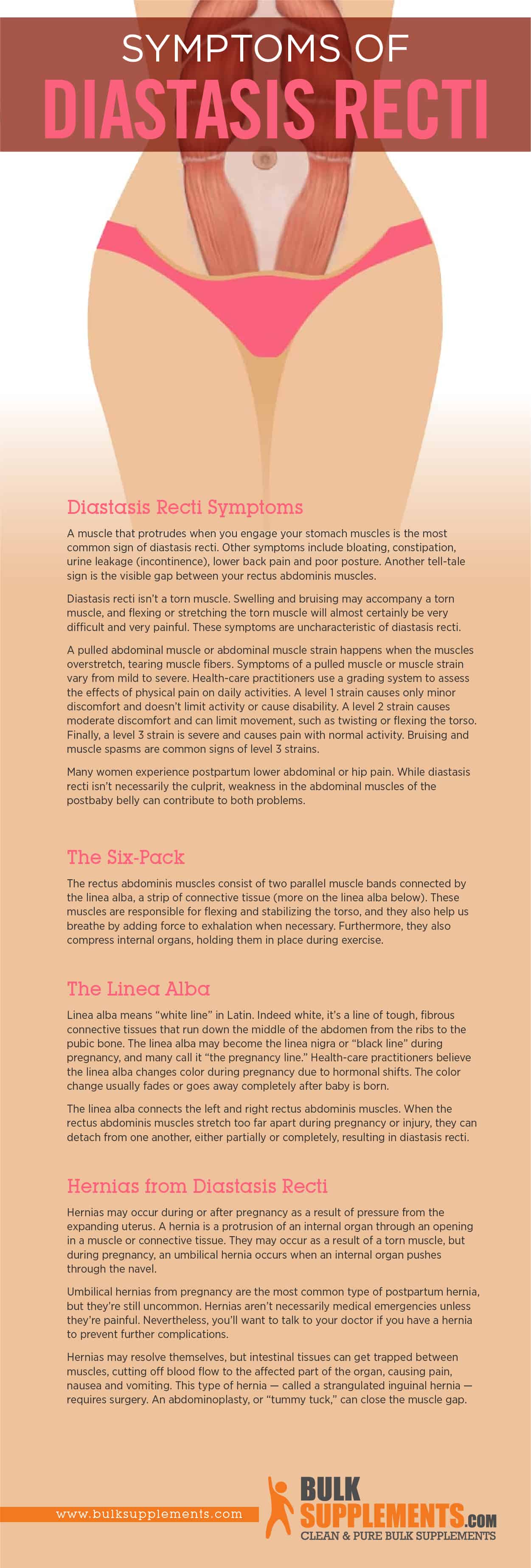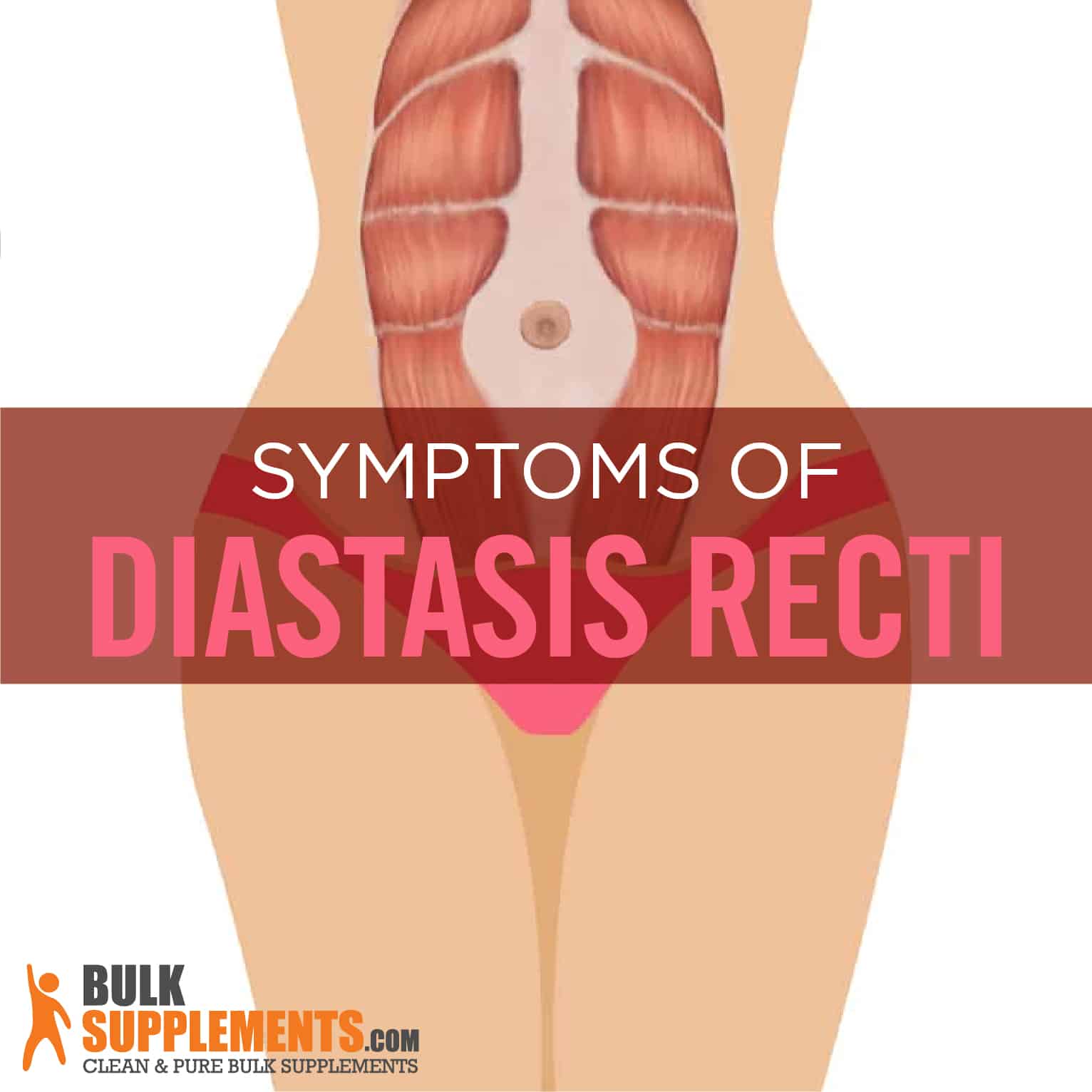What is Diastasis Recti?
Diastasis recti is a condition defined as a separation of the front stomach muscles (rectus abdominis). It’s common during pregnancy (up to two-thirds of pregnant women experience it), but it can happen to anyone. Diastasis recti in men sometimes occurs as a result of incorrect posturing during weight lifting or abdominal exercises or overtraining the abdominal muscles (x).
Anatomy 101: The Abdominal Muscles
The stomach muscles are made up of multiple layers of muscle. The deepest layer belongs to the transverse abdominal muscles (TVAs), which run down and along the inside of the abdominal wall. On top of the TVAs rest the internal and external obliques, the latter on top of the former, and on top of the obliques rest the rectus abdominis muscles, the outermost layer, sometimes visible. These are your “six-pack,” if unlike many of us you put time into buffing them up.
The Six-Pack
The rectus abdominis muscles consist of two parallel muscle bands connected by the linea alba, a strip of connective tissue (more on the linea alba below). These muscles are responsible for flexing and stabilizing the torso, and they also help us breathe by adding force to exhalation when necessary. Furthermore, they also compress internal organs, holding them in place during exercise (x).
The Linea Alba
Linea alba means “white line” in Latin. Indeed white, it’s a line of tough, fibrous connective tissues that run down the middle of the abdomen from the ribs to the pubic bone. The linea alba may become the linea nigra or “black line” during pregnancy, and many call it “the pregnancy line.” Health-care practitioners believe the linea alba changes color during pregnancy due to hormonal shifts. The color change usually fades or goes away completely after the baby is born (x).
The linea alba connects the left and right rectus abdominis muscles. When the rectus abdominis muscles stretch too far apart during pregnancy or injury, they can detach from one another, either partially or completely, resulting in diastasis recti.
Pregnancy and Diastasis Recti
Sometimes during pregnancy, the belly button may pop out from the rapid expansion of the uterus. This often happens during the second trimester. A protruding belly button is no cause for concern and doesn’t mean you’ll develop diastasis recti. The postpartum stomach takes a little time to fully recover, but never fear — most belly buttons return to their “innie” position within a few months after delivery. Women who’ve had multiple pregnancies (particularly those close together) or multiple-birth pregnancies, as well as women over 35, are more likely to develop diastasis recti (x).
Complications from Diastasis Recti during Pregnancy
While the condition isn’t itself cause for concern, diastasis recti can cause some complications. The abdominal muscles may weaken from their stretching apart, which may result in poor posturing or lower back pain. Umbilical hernias are another possibility, particularly in the second and third trimesters (x).
Hernias from Diastasis Recti
Hernias may occur during or after pregnancy as a result of pressure from the expanding uterus. A hernia is a protrusion of an internal organ through an opening in a muscle or connective tissue. They may occur as a result of a torn muscle, but during pregnancy, an umbilical hernia occurs when an internal organ pushes through the navel (x).
Umbilical hernias from pregnancy are the most common type of postpartum hernia, but they’re still uncommon. Hernias aren’t necessarily medical emergencies unless they’re painful. Nevertheless, you’ll want to talk to your doctor if you have a hernia to prevent further complications (x).
Hernias may resolve themselves, but intestinal tissues can get trapped between muscles, cutting off blood flow to the affected part of the organ, causing pain, nausea and vomiting. This type of hernia — called a strangulated inguinal hernia — requires surgery (x). An abdominoplasty, or “tummy tuck,” can close the muscle gap.
Treatments for Diastasis Recti
Diastasis recti usually resolves itself. The case is especially true for pregnant women with diastasis recti and babies born with it (x). However, treatments for it do exist. An abdominal wrap or brace can help support the abdominal muscles while they heal at first, but this solution is only short term (x).
Stretching and Exercise
Mild to moderate exercise, such as crunches while using the hands to push the abdominal muscles together, can help to reduce the size of the gap between the muscles (x). However, health-care practitioners usually don’t advise regular sit-ups since they can increase pressure on the abdominal muscles and make the problem worse. Physical therapists may also suggest other exercises to heal diastasis recti (x).
Abdominal stretches can help improve your core’s flexibility and may decrease your risk of developing diastasis recti. Maintaining your fitness level and working out stomach muscles during pregnancy can also help prevent it. Light abdominal exercises may also speed postpartum recovery.
While many health-care practitioners don’t recommend full sit-ups and double leg-lifts during pregnancy, planks, standing crunches, pelvic tucks and the bird-dog yoga pose are generally safe. You can also try heel slides, single drops and knee-lifts in a side-lying position (x).
Diastasis Recti Symptoms
A muscle that protrudes when you engage your stomach muscles is the most common sign of diastasis recti. Other symptoms include bloating, constipation, urine leakage (incontinence), lower back pain and poor posture (x). Another tell-tale sign is the visible gap between your rectus abdominis muscles.
Diastasis recti isn’t a torn muscle. Swelling and bruising may accompany a torn muscle, and flexing or stretching the torn muscle will almost certainly be very difficult and very painful. These symptoms are uncharacteristic of diastasis recti.
A pulled abdominal muscle or abdominal muscle strain happens when the muscles overstretch, tearing muscle fibers. Symptoms of a pulled muscle or muscle strain vary from mild to severe. Health-care practitioners use a grading system to assess the effects of physical pain on daily activities. A level 1 strain causes only minor discomfort and doesn’t limit activity or cause disability. A level 2 strain causes moderate discomfort and can limit movement, such as twisting or flexing the torso. Finally, a level 3 strain is severe and causes pain with normal activity. Bruising and muscle spasms are common signs of level 3 strains (x).
Many women experience postpartum lower abdominal or hip pain. While diastasis recti isn’t necessarily the culprit, weakness in the abdominal muscles of the postbaby belly can contribute to both problems (x).

Diastasis Recti Causes
The usual causes of diastasis recti include weak connective tissue along the linea alba, pregnancy and incorrect posturing during exercise and weight lifting. Other causes of diastasis recti, which we haven’t discussed, include excess abdominal fat, genetics and yo-yo dieting — the cycle of losing weight, regaining it and dieting to lose it again.
Diastasis Recti Supplements
Supplements that support strong muscles and other soft tissues include collagen; vitamins A, C and E; zinc, magnesium and calcium; resveratrol and quercetin.
If you have diastasis recti and would like to facilitate its healing, you may want to try any of the supplements listed below. Before you do, talk to your doctor to determine whether supplementation is right for you.
Be sure to mention our dose guidelines (also listed below) to your doctor as your doctor may suggest you change your dose. Also worth noting is that dose guidelines may change between supplement types (powders and capsules).
Follow dose guidelines on supplement packaging if you don’t have a family doctor or if your doctor is unavailable to consult with, and take each supplement with plenty of water.
Collagen
Collagen is chock-full of amino acids and essential for healthy muscles, bone, skin, tendons and cartilage. A collagen supplement can help strengthen abdominal muscles and connective tissues, such as the linea alba, after pregnancy. For adults, the recommended dose of collagen powder is 2,500 milligrams two to four times daily. Take collagen on an empty stomach, but with plenty of water.
Vitamin A
Vitamin A is essential for the body to synthesize protein for muscle repair. Take no more than 30 grams of vitamin A powder once daily.
Vitamin C
Vitamin C is a precursor to collagen and also slows its breakdown. As an anti-inflammatory, vitamin C may reduce pain and stiffness in the muscles and joints. For adults, take no more than 1,000 milligrams of the powder daily.
Vitamin E
Vitamin E also boosts the body’s production of collagen, helping the repair and strengthening of muscles and connective tissues. For adults, take between 500 and 1,000 milligrams of the powder daily with meals.
Zinc
Zinc is essential for the synthesis of protein and connective tissues. It also neutralizes free radicals, which can slow muscular healing. Dose guidelines for zinc supplements vary greatly between supplement types — too greatly to list here. They range from 32 milligrams once daily to 450 milligrams once daily. Check the packaging on your supplement and talk to your doctor to determine the correct dosage.
Resveratrol
Resveratrol is an anti-inflammatory compound found in the skin of grapes. Studies have shown that it reduces damage to bodily tissues (x). Take one capsule once daily or 250 milligrams of the powder twice daily.
Quercetin
Quercetin is another powerful anti-inflammatory that also helps the body remove toxins and reduce tissue damage from free radicals (x). For adults, take between 250 and 500 milligrams of the powder three times daily.
Magnesium
Magnesium is an essential nutrient for hundreds of important chemical reactions that take place inside the body, including protein synthesis. Furthermore, magnesium helps to prevent and relieve muscle spasms and cramps (x). As they do with our zinc supplements, dose guidelines for magnesium supplements very greatly between supplement types. Talk to your doctor for their recommended daily dose, or follow the dose guidelines on the supplement packaging.
Calcium
Calcium not only strengthens and repairs bones, but also helps the muscles function properly. A deficiency in calcium can cause weakness, twitching and cramps (x). As they do with our zinc and magnesium supplements, dose guidelines for calcium supplements very greatly between supplement types. Talk to your doctor for their recommended daily dose, or follow the dose guidelines on the supplement packaging.
The Bottom Line
Diastasis recti occurs often in pregnancy and sometimes in newborns, but it can happen in men, too. Incorrect posturing during exercise, especially during weight lifting, is a primary cause of diastasis recti in men. The condition usually resolves itself with time, but maintaining a strong core and taking supplements such as collagen, calcium and magnesium can help strengthen the abdominal muscles and connective tissues, preventing the condition’s onset and accelerating its healing.


